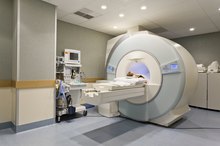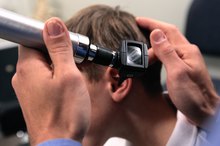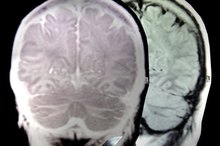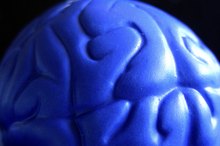What does fact checked mean?
At Healthfully, we strive to deliver objective content that is accurate and up-to-date. Our team periodically reviews articles in order to ensure content quality. The sources cited below consist of evidence from peer-reviewed journals, prominent medical organizations, academic associations, and government data.
The information contained on this site is for informational purposes only, and should not be used as a substitute for the advice of a professional health care provider. Please check with the appropriate physician regarding health questions and concerns. Although we strive to deliver accurate and up-to-date information, no guarantee to that effect is made.
What the Different Parts of the Brain Do?
The brain and the spinal cord make up the central nervous system, which receives signals from the peripheral nervous systems (the nerves in the body), interprets them and sends out instructions for motor activity -- all in less than a second. Each part of the brain has a specific function, some of which are still unknown to scientists.
If you are experiencing serious medical symptoms, seek emergency treatment immediately.
Cerebrum
The cerebrum is the wrinkled upper half of the brain, what is normally thought of when people think "brain." The deep wrinkles, called sulci, increase the surface area so more information can be processed. The cerebrum is divided into two hemispheres, and each hemisphere has four lobes: frontal, parietal, temporal and occipital.
Lobes of the Cerebrum
What Parts of the Brain Control the Parts of Your Body?
Learn More
The frontal lobe, behind the forehead, controls thinking, planning, judgment and movement. The parietal lobe, on the top of the head, interprets sensory information from the nerves regarding taste, smell and touch. The occipital lobe in the back of the head processes visual information. The temporal lobe, on the sides near the temples, processes sensory information from taste, smell and sound, and many memories are stored there as well.
- The frontal lobe, behind the forehead, controls thinking, planning, judgment and movement.
- The parietal lobe, on the top of the head, interprets sensory information from the nerves regarding taste, smell and touch.
Cerebellum
The cerebellum is located in the back of the head below the occipital lobe. It combines sensory information to help coordinate movement -- it is also the part of the brain that helps you pass a field sobriety test from law enforcement by enabling you to touch your nose with your eyes closed and walk a straight line heel to toe.
Brain Stem
Parts of the Brain Involved With Hearing
Learn More
The brain stem includes the midbrain, the pons and the medulla oblongata 1. The brain stem is very important to life, regulating heart rate, blood pressure, body temperature and sleeping. Also, any nerve impulse traveling to the brain from the spinal cord must first pass through the brain stem.
Diencephalon
Just above the brain stem is the diencephalon, which is made up of the thalamus and hypothalamus. The thalamus is the gatekeeper for messages sent to and from the cerebrum and the spinal cord. The hypothalamus controls body temperature and vital urges such as thirst, hunger and fatigue.
Related Articles
References
- Mayo Clinic: How the Brain Works
- The Lundbeck Institute
- Boly M, Massimini M, Tsuchiya N, Postle BR, Koch C, Tononi G. Are the Neural Correlates of Consciousness in the Front or in the Back of the Cerebral Cortex? Clinical and Neuroimaging Evidence. J Neurosci. 2017;37(40):9603-9613.
- Jawabri KH.Physiology, Cerebral Cortex Functions.StatPearls [Internet]. Treasure Island (FL): StatPearls Publishing; 2019-. Accessed June 22, 2019
- Hurley RA, Flashman LA, Chow TW, Taber KH. The brainstem: anatomy, assessment, and clinical syndromes. J Neuropsychiatry Clin Neurosci. 2010;22(1):iv, 1-7. doi: 10.1176/jnp.2010.22.1.iv
- Wagner MJ, Kim TH, Savall J, Schnitzer MJ, Luo L. Cerebellar granule cells encode the expectation of reward. Nature. 2017;544(7648):96-100. doi: 10.1038/nature21726
- Fama R, Sullivan EV. Thalamic structures and associated cognitive functions: Relations with age and aging. Neurosci Biobehav Rev. 2015;54:29-37. doi: 10.1016/j.neubiorev.2015.03.008
- Biran J, Tahor M, Wircer E, Levkowitz G. Role of developmental factors in hypothalamic function. Front Neuroanat. 2015;9:47. doi: 10.3389/fnana.2015.00047
- Anand KS, Dhikav V. Hippocampus in health and disease: An overview. Ann Indian Acad Neurol. 2012;15(4):239-46. doi: 10.4103/0972-2327.104323
- Lanciego JL, Luquin N, Obeso JA. Functional neuroanatomy of the basal ganglia. Cold Spring Harb Perspect Med. 2012;2(12):a009621. doi: 10.1101/cshperspect.a009621
- Carter, R. The Human Brain Book. New York: Penguin; 2014.
- Kalat, JW. Biological Psychology. Boston, MA: Cengage Learning; 2016.
Writer Bio
Denise M. Covert is a registered nurse, writer and editor from Florida. She has been a journalist for more than 15 years and holds degrees in journalism, music and nursing. After working for daily newspapers for years, she now serves as a nurse on a cardiac floor at a major hospital.








